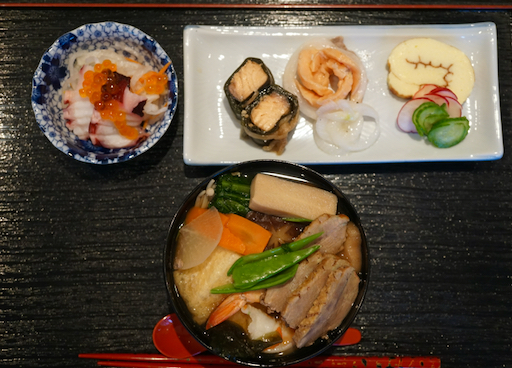Oregon mushrooms just started shipping North American fresh matsutake. Although North American matsutake is no comparison to the Japanese or even Mexican variety, we usually get them just to commemorate the season.
As I posted before, this matsutake requires more aggressive cleaning since the dirt is embedded into the skin of the mushroom and just rubbing with a moist towel does not do the job.
I have posted everything posted here and some more. But this is a once a year matsutake feast.
Since I do not have an appropriate set of "
dobin-mushi" 土瓶蒸し vessels, I used mini-donabes to serve Matsutake soup 松茸のお吸い物.
For color, I added blanched broccolini, thinly shaved carrot and chives. I also added cubes of cod and shrimp.
The soup base is bonito-kelp broth (using a dashi pack) and seasoned with mirin and light colored "usukuchi" soy sauce 薄口醤油. The cod and shrimp (Venezuelan red shrimp), both were previously frozen, stored in our freezer and thawed the morning I made the dish. I salted and marinated them in sake before adding to the soup. Upon opening the lids of the soup containers, the lovely matsutake aroma wafted up. (This initial whiff of matsutake fragrance is one of the traditional "enjoyments" of this dish.) This is the first time I used cod for this type of soup (any gentle tasting white meat fish will do). The cod was thick fleshed and tender and really good. The shrimp was sweet and excellent as well.
I was planning to have a
chawanmushi 松茸の茶碗蒸し next but it took longer than I planned for it to finish cooking so I served
matustake touban yaki 松茸の陶板焼き next. We enjoyed it simply with salt and lemon.
Finally, the chawanmush was done. For this batch, I added the cod, shrimp, kyo-bu 京麩 (dried gluten cake, rehydrated), a cube of
dashimaki だし巻き Japanese omelet (
egg-in-egg idea). As usual, I made six so that we could enjoy the "leftovers" later.
I garnished it with finely chopped fresh chives. The soft egg custard was infused with matsutake aroma/flavor.
#1. This is the amount of matsutake I used for 6 small chawanmushi (about three matsutake).
#2. The first layer of the chawanmush is, of course, the matsutake.
#3. Kyo-bu is a small decorative gluten cake from Kyoto. It does not have any taste by itself. Just texture and whatever it absorbed.
#4. Shrimp.
#5. Cod.
#6. Cube of dashimaki.
This was a sort-of treasure hunt. We love chawanmushi of any kind but this was a bit special. I used to add ginko nuts which, in the past, were readily available in a can (boiled) but not anymore for some reason. They just disappeared and we have not seen them anywhere. Finally we finished our feast with matsutake-gohan 松茸ご飯. This time I think I made it perfectly. The rice was slightly firm but well cooked.
For this occasion, I wheeled out my special "Kamado-san" earthenware rice cooking pot (#1). As per the instructions, I set the inner lid with its steam holes arranged perpendicular to the outer lid steam hole; necessary for the rice to cook properly(#2). As usual, I used bonito-kelp broth seasoned with mirin and light colored soy sauce which I enhanced by adding rehydrated strips of kelp and soaking liquid. When the lid was lifted, the smell the matsutake and freshly cooked rice (good combination) wafted up (#3). I mixed the rice and the matsutake before serving (#4).
Besides, the matsutake dishes, we had a few more of our usual appetizers and cold sake. Once a year, this is worth doing.




















































